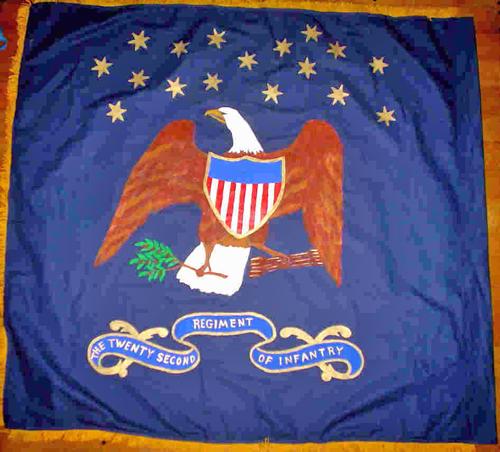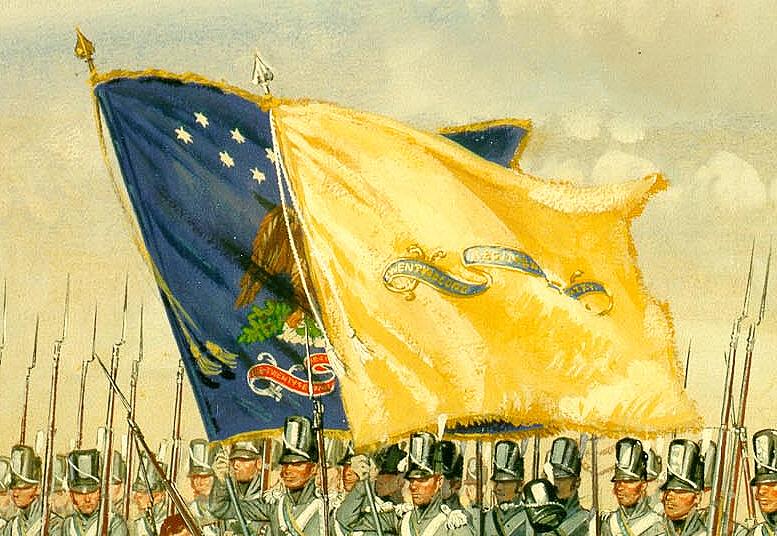![]() 1st Battalion 22nd Infantry
1st Battalion 22nd Infantry ![]()
Birth of the U.S. 22nd Infantry Regiment

A reproduction of the
first "Colors" of the 22nd Infantry.
The eagle chosen as the symbol of the US, is clutching an olive
branch in one foot and arrows in his other. The shield on his
breast represents
the Union, with thirteen red and white stripes for the original
colonies. The gold or yellow six pointed stars at the top are for
the seventeen States
which made up the United States at the beginning of 1812.
(Louisiana joined the Union on April 30, 1812, so technically
there should be eighteen stars.)
The color of the flag is dark blue, with a gold or yellow fringe.
The scroll is blue, outlined in yellow with yellow lettering.
Photo from the Sand Hill Flag Company
June 26, 2012 marked the 200th birthday of the
United States 22nd Regiment of Infantry. Formed to fight in the
War of 1812 and disbanded immediately after the end of the war,
the 22nd performed admirably in those first two years of its
existence. Here is a short history of the birth of our Regiment.
The aversion to a standing army by the Founding Fathers after the
Revolutionary War left the young United States with only two
regiments of Infantry in Federal service. The various State
militias were considered a sufficient force which could be called
upon in time of war to defend the country. As the young nation
grew and attempted to make a place for itself in the
international community incidents and troubles with other nations
caused President Thomas Jefferson to grudgingly secure from
Congress the authorization for five new regiments of Infantry in
1807. In late 1811 as war with England began to appear
inevitable, Jefferson's successor, James Madison, asked Congress
to increase the size of the Army and in January 1812 ten new
regiments of Infantry were authorized. On June 18, 1812 the
United States declared war on Great Britain. During the next two
years the US Army's Infantry would gradually be increased from
seventeen to a total of forty-six regiments.
By an Act of Congress the 22nd US Infantry Regiment was one of
eighteen new regiments authorized and constituted on June 26,
1812, just eight days after the Declaration of War. Commissioned
as a Colonel and given command of the 22nd was Hugh Brady of
Pennsylvania, a veteran of the Battle of Fallen Timbers in 1794
and a member of the Pennsylvania militia. His second in command
was Lieutenant Colonel George McFeely of Cumberland County,
Pennsylvania. For the next two years Brady would be ordered on
recruiting duty for the Regiment in the State of Pennsylvania,
alternating among various posts, mostly at Pittsburgh and
Carlisle. Many of the recruits would come from Pennsylvania
itself and indeed the Regiment in its early days would be known
as a Pennsylvania Regiment though it was not under State control.
Brady would supervise the recruiting and as soon as a sizeable
body of men were trained he would send them to LTC McFeely who
would command the Regiment in the field during its first
engagements with the enemy.
The size of an Infantry Company in those days consisted of one
hundred privates, eleven non-commissioned officers and five
commissioned officers. Companies were not alphabetically named
but rather were named after the Captain who commanded them. In
the 22nd Infantry such Companies were Captain Foulk's Company,
Captain Henderson's Company, etc. Recruiting however was slow and
detachments of trained Soldiers were sent to McFeely in whatever
amounts as could be produced. Most companies therefore operated
with nowhere near the total strength they were allocated. In
November of 1812 McFeely took 180 men of the 22nd into the
Regiment's first action with the enemy at Fort Niagara, New York.
During the bombardment of the Fort that month the 22nd suffered
its first casualties of one killed and one wounded. On May 27,
1813 the 22nd fought at the battle of Fort George losing ten
wounded. In July 1813 Surgeon Julius Shumate was killed in action
during a skirmish at a place that was not recorded. In November
1813 the 22nd was present at the battle of French Creek and in
December 1813 the 22nd Infantry Regiment was recorded as
consisting of 455 men. The 22nd wintered that year in French
Mills, New York before marching to Buffalo to become part of
General Winfield Scott's Brigade. McFeely was not present at this
time and the body of 22nd Infantry was united with a small body
of the 9th Infantry and placed under command of Colonel Henry
Leavenworth of the 9th, giving Leavenworth a combined command of
9th/22nd in Scott's Brigade. Under Scott the 22nd received
intensive training as he prepared his brigade to meet the British
Army on equal terms. The British Army was the best in the world
at that time and many in its ranks were veterans of the long wars
against Napoleon. The American Army by contrast, raised from a
civilian population to fight this war, was an army of amateurs
and considered no match for such a seasoned force.
Scott drilled and trained his men constantly, instilling in them
confidence, pride and cohesion as a unit, as he molded them into
a force that could stand up to the British. Due to a shortage in
the supply system of the standard blue cloth for uniform coats,
Scott outfitted most of his Brigade in the readily available and
easily and cheaply produced color of cloth known as
"drab", which was gray in color and adopted by most US
militia as their uniform. It was in this uniform that Scott
marched his Brigade onto the field at Chippewa on July 5, 1814 to
face a British and Canadian force. Because of their gray coats
the British mistook the American Soldiers for militia, believing
they would have an easy victory since American militia in this
war had not been able to defeat His Majesty's veterans. As
Scott's Brigade steadily marched onward through cannon and musket
fire with the 9th/22nd Infantry on the right of the line the
enemy realized they were faced by disciplined and professional
Soldiers, not militia, and their commander is said to have
exclaimed "Those are not militia, those are Regulars, By
God!", a description which has come down through the years
to be uttered with pride by members of today's Regiment. This
incident was forever immortalized by the artist H.C. McBarron in
the painting he did for the US Army In Action Series of 1953 in
which he shows a line of the 22nd Infantry advancing under fire
carrying their colors and battle flag.

A section of the
painting by H.C. McBarron showing the 22nd Infantry advancing at
Chippewa in their gray jackets.
The dark blue flag is the Colors of the Regiment with a scroll at
the bottom denoting "TWENTYSECOND REGIMENT
INFANTRY", shown by McBarron as a red scroll outlined in
white with gold or yellow lettering. The yellow flag is the
battle flag of the Regiment with a scroll denoting
"TWENTYSECOND REGIMENT INFANTRY", the scroll is blue
outlined in gold or yellow with gold or yellow lettering.
McBarron's painting was
created as one in a series of posters made for the U.S. Army in
the early 1950's.
The original title of the poster when first printed was "Regulars,
By God !"
Through his tactics and the professionalism shown by his Soldiers
Scott drove the British from the field that day which resulted
not only in an American victory but also issued a statement to
the world that this new American nation could defend itself from
the best the world had to offer. It was the first time in the war
that the United States Army had stood face to face on an open
battlefield with the British Army and soundly defeated them using
the military tactics of the day. It was the day the young United
States Army became a professional arm of combat. The 22nd
Infantry lost thirteen killed and forty-six wounded during the
battle. A short time later on July 25, 1814 the 22nd fought in
the battle of Lundy's Lane, one of the two bloodiest engagements
of the war. By this time Colonel Hugh Brady had managed to secure
release from his recruiting duties, brought several more
companies of the 22nd with him, joined Scott's Brigade and
commanded the Regiment in this battle until he was severely
wounded. The 22nd was the hardest hit of all the Regiments in the
battle at Lundy's Lane, losing 39 dead, 90 wounded and 22 missing
in action. During the months of August and September 1814 the
22nd participated in the defense of Fort Erie, suffering another
ten killed and forty-two wounded.
In February 1815 the 22nd Infantry was stationed at Sacket's
Harbor, New York with Colonel Brady in command of approximately
400 men. With the war over, on March 3, 1815, an Act of Congress
reduced the Army's forty-six Regiments of Infantry down to a
peacetime Army of just eight Infantry Regiments. (The Army's
current regimental numbering system dates from this act.) At Fort
Pike, Sacket's Harbor the 22nd Infantry was consolidated with the
6th, 16th, 23rd and 32nd Regiments to form the new US 2nd
Regiment of Infantry with Colonel Hugh Brady as Commander. Thus,
the 22nd Infantry Regiment simply, in the eyes of the Army,
ceased to exist. During the Civil War the Army had only nineteen
US Infantry Regiments. That war was fought by Regiments raised by
the individual States. In September of 1866 the 22nd Infantry was
reconstituted from two Companies ( A and I ) of the 13th
Infantry. Therefore, today's Army traces the birth and lineage of
the 22nd Infantry Regiment only back to 1866, when the Regiment
was re-constituted for the first time since 1815. In the eyes of
the Army’s lineage and honors system our Regiment’s
beginnings only go back to those two Companies of the 13th
Infantry when they were formed in 1861 and when they became the
22nd Infantry in 1866.
We presently serving Soldiers and veterans of the 22nd Infantry
feel differently. We know that our unofficial motto of
"Regulars By God" comes from that original 22nd
Infantry Regiment of 1812. We know that the gray uniform coats
worn by cadets at West Point are in honor of those gray jackets
worn by the original 22nd Infantry as they won the first open
battlefield victory by the United States Army against the world's
best army in the War of 1812. We know that our pride and
professionalism is handed down from that original 22nd Regiment
of Infantry as they proved on the field at Chippewa that the
young United States Army had become as good as any in the world.
We know that the 22nd US Regiment of Infantry was born on June
26, 1812 and we wish ourselves a Happy 200th Birthday.
Michael Belis
DMOR
June 2012
Home | Photos | Battles & History | Current |
Rosters & Reports | Medal of Honor | Killed
in Action |
Personnel Locator | Commanders | Station
List | Campaigns |
Honors | Insignia & Memorabilia | 4-42
Artillery | Taps |
What's New | Editorial | Links |